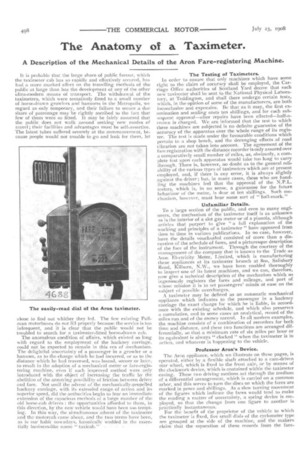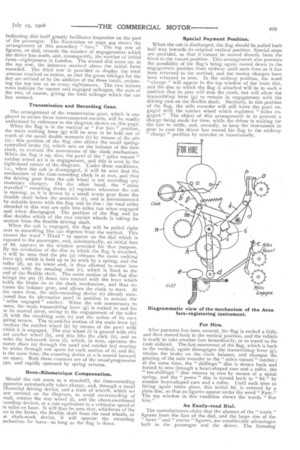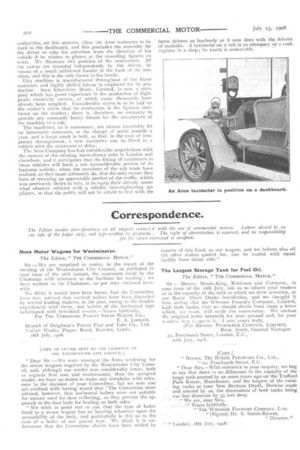The Anatomy of a Taximeter.
Page 16

Page 17

Page 18

If you've noticed an error in this article please click here to report it so we can fix it.
A Description of the Mechanical Details of the Aron Fare-registering Machine.
It is probable that the large share of public favour, which the taximeter cab has so rapidly and effectively secured, has had a more marked effect on the travelling methods of the public at large than has the development of any of the other ultra-modern means of transport. The withdrawal of the taximeters, which were tentatively fitted to a small number of horse-drawn growlers and hansoms in the Metropolis, we regard as only temporary, and their failure to secure a due share of patronage may be rightly ascribed to the fact that few of them were so fitted. It may be fairly assumed that the public does not walk around seeking new modes of travel; their facilities and advantages must be self-assertive, The latest tubes suffered severely at the commencement, because people would not trouble to go and look for them, let alone to find out whither they led. The few existing Pullman motorbuses do not fill properly because the service is too infrequent, and it is clear that the public would not be troubled to search for a taximeter-fitted horse-drawn cab.
The anomalous condition of affairs, which existed so long with regard to the employment of the hackney carriage, could not be expected to remain in this era of mechanism. The delightful uncertainty of a passenger in a growler or a hansom, as to the charge which he had incurred, or as to the distance which he had traversed, was bound, sooner or later, to result in the adoption of a mechanical meter or fare-registering machine, even if such improved method were only introduced with the object of increasing the traffic by the abolition of the annoying possibility of friction between driver and fare. Not until the advent of the mechanically-propelled hackney carriage, with its extended range of action and its superior speed, did the authorities begin to fear an immediate extension of the rapacious methods of a large number of the old horse-cab drivers : the opportunities afforded to them, in this direction, by the new vehicle would have been toc) tempting. In this way, the simultaneous advent of the taximeter and the motorcah camp about, and the two terms have been, as is our habit nowadays, laconically wedded in the essentially business-like -name " taxicab."
The Testing of Taximeters.
In order to ensure that only machines which have some right to the claim of accuracy shall be employed, the Carriage Office authorities of Scotland Yard decree that each new taximeter shall be sent to the National Physical Laboratory, at Teddington, and shall there undergo certain tests, which, in the opinion of some of the manufacturers, are both inconclusive and expensive. Be that as it may, the first examination and sealing costs ten shillings, and for each subsequent approval—after repairs have been effected—half-acrown is charged. We are informed that the test to which these machines are subjected is no definite guarantee of the accuracy of the apparatus over the whole range of its register. The test is made under the favourable conditions which pertain to a shop bench, and the deranging effects of road vibration are not taken into account. The agreement of the fare registration with the distance recorder is only assured over a comparatively small number of miles, as, obviously, a complete test upon each apparatus would take too long to carry through. There is, however, no doubt as to the general reliability of the various types of taximeters which Are at present employed, and, if there is any error, it is always slightly against the driver; but, in many cases, those who are handling the machines feel that the approval of the N.P.L. testers, which is, in no sense, a guarantee for the future behaviour of the meter, is dear at ten shillings. Such mechanism, however, must bear some sort of " hall-mark,"
Unfamiliar Details.
To a large section of the public, and even to many engineers, the mechanism of the taximeter itself is as unknown as is the interior of a slot gas meter or of a pianola, although articles that purport to give " a full explanation of the working and principles of a taximeter " have appeared from time to time in various publications. In no case, however, have the details vouchsafed consisted of more than a discussion of the schedule of fares, and a picturesque description of the face of the instrument. Through the courtesy of the management of the company that is known to the Trade as Aron Electricity Meter, Limited, which is manufacturing these appliances at its taximeter hranch at Soa, Salisbury Road, Kilburn, N.W., we have been enabled thoroughly to inspect one of its latest machines, and we can, therefore, now give a technical description of the mechanism which so ingeniously registers the fares and mileage, and part of whose mission it: is to set passengers' minds at ease on the subject of possible overcharges. A taximeter may be defined as an automatic mechanical appliance which indicates to the passenger in a hackney carriage the exact charge for which he is liable, in accordance with the existing schedule, and which also preserves a cumulative, and in some cases an analytical, record of the miles run and of the money earned. In all modern examples, the machine consists of a combination of recorders for both time and distance, and these two functions are arranged differentially, so that a minimum rate of six miles per hour or its equivalent is always " clocked " when the taximeter is in action, and whatever is happening to the vehicle.
Professor Aron's Device.
The Aron appliance, which we illustrate on these pages, is operated, either by a flexible shaft attached to a cam-driven star wheel, which is fixed to the front axle, or by means of the clockwork device, which is contained within the taximeter casing. These two driving motions act through the medium of a differential arrangement, which is carried on a common arbor, and this serves to turn the discs on which the fares are marked in pence and shillings. As a slow turning movement of the figures which indicate the fares would tend to make the reading a matter of uncertainty, a spring device is employed, so that the change from one figure to another is practically instantaneous. For the benefit of the proprietor of the vehicle to which the taximeter is fixed, five small dials of the cyclometer type are grouped at the side of the machine, and the makers claim that the separation of these records from the fare
indicating dial itself greatly facilitates inspection on the part of the passenger. The illustration on page 494 shows the arrangement of this secondary " face." The top row of figures, or dial, records the number of engagements which the driver has made, and, consequently, the number of initial fares—eig-htpences in London. The second dial sums up, in the top row, the balances received above the initial fares recorded. The third row is provided to display the total amount received as extras, so that the gross takings for the day are arrived at by the addition of the three totals, reckoning the top row as so many eightpences.. The two bottom rows indicate the vacant and engaged mileages, the sum of the two, of course, giving the total mileage which the car has covered.
Transmission and Recording Gear.
The arrangement of the transmission gear, which is employed to secure these interconnected records, will be readily understood by reference to the diagram shown on this page.
When the flag is in the vertical or " For hire " position, the main rocking lever (g) will be seen to be held out of reach of the small double eccentric (e) by means of the pin (a) : this position of the flag also allows the small springcontrolled brake (b), which acts on the balance of the time clock, to restrain the movements of the clock mechanism. While the flag is up, also, the pawl of the "miles vacant " ratchet wheel (c) is in engagement, and this is seen in the right-hand corner of the diagram. Under these conditions, i.e., when the cab is disengaged, it will be seen that the mechanism of the time-recording clock is at rest, and that the driving gear from the cab wheel is not recording any monetary charges. On the other hand, the " miles travelled " recording device (c) registers whenever the cab is moving, as it is driven by a small worm gear from the flexible shaft below the eccentric (e), and is interconnected by suitable levers with the flag and its disc : the total miles recorded in this way are split into miles run when engaged and when disengaged. The position of the flag and its disc decides which of the two ratchet wheels is taking its motion from the flexible driving shaft.
When the cab is engaged, the flag will be pulled right over to something like 120 degrees from the vertical. This causes the word " Hired " to appear on the dial which is exposed to the passenger, and, automatically, an initial fare of 8d. appears in the window provided for that purpose. By the revolution of the disc to which the flag is attached, it will be seen that the pin (a) releases the main rocking lever (g), which is held up to its work by a spring, and the roller (d), on its lower end, is thus allowed to come into contact with the rotating cam (e), which is fixed to the end of the flexible shaft. The same motion of the flag disc brings the pin (f) down into contact with the lever which holds the brake on to the clock mechanism, and thus releases the balance gear, and allows the clock to start. At the same time, the mile-recording device (c) already menioned has its alternative pawl in position to actuate the miles engaged " ratchet. When the cab commences to nave, the main transmitting lever (g) is rocked to and fro m its central pivot, owing to the engagement of the roller :d) with the revolving cam (e) and the action of its own ipring return. The to.ancl-fro motion of the main lever (g) -evolves the ratchet wheel (h) by means of the pawl with which it is engaged. The star wheel (i) is geared with this ast ratchet wheel (h), and this lifts the click (k), and so .ocks the bell-crank lever (I), which, in turn, operates the noney discs (n) through the pawl and ratchet (m) moving he series through one space for each motion of (i) and (k). It the same time, the counting device at o is moved forward .ne space. Both these counters are of the usual progressive ype, and rapidly operated by spring returns.
Horo-Iiilomettique Compensation.
Should the cab come to a standstill, the time-recording pparatus automatically takes charge, and, through a small ifTerential driving device, and a train of wheel, which we ave omitted on the diagram, to avoid overcrowding of etail, rotates the star wheel (i), and the above-mentioned :cording devices, at a rate equivalent to a vehicular speed of ix miles an hour. It will thus be seen that, whichever of the ,vo is the faster, the flexible shaft from the road wheels, or le clock-work device, it will operate. the recording iechanism for fares—so long as the flag is down. Special Payment Position.
When .the cab is discharged, the flag should be pulled back half Way towards its original vertical position. Special stops are provided, so that it cannot be moved directly from the hired to the vacant position. This arrangement also prevents the possibility of the flag's being again moved down to the engagement position from midway until such time as it has been returned to the vertical, and the money charges have been returned to zero. In the midway position, the word "charge " will appear in the top window of the front dial, and the disc to which the flag is attached will be in such a position that its pins will stop the clock, but will allow the transmitting lever (g) to remain in engagement with the driving cam on the flexible shaft. Similarly, in this position of the flag, the mile recorder will still leave the pawl engaged with the ratchet wheel which registers " miles engaged." The object of this arrangement is to prevent a charge being made for time, while the driver is waiting for the fare to settle, and, secondly, to keep the instrument in gear in case the driver has moved his flag to the midway " charge " position by mistake or intentionally.
For Hire.
After payment has been secured, the flag is rocked a little, and then moved back to the vertical position, and the vehicle is ready to take another fare immediately, or to travel to the rank unhired. The last movement of the flag, which is back to the vertical, again disengages the transmitting lever (g), retains the brake on the clock balance, and changes the gearing of the mile recorder to the " miles vacant" ratchet; at the same time, the " shillings " disc is drawn back and teened to zero through a heart-shaped cam and a roller, the " ten-shillings " disc returns to zero by means of a spiral spring, and the " pence " disc is turned back to "8d." by • another heart-shaped cam and a roller. Until such time as hiring again takes place, this initial 8d. is covered by a plain disc, so that no figures appear under the word" Fare." The top window in this condition shows the words " For hire."
An Easily-read Dial.
The manufacturers claim that the absence of the " totals" figures from the face of the dial, and the large size of the " fares " and " extras " figures, are considerable advantages both to the passenger and the driver. The licensing
authorities, on this account; allow the Aron taximeter to be fixed to the dashboard, and this precludes the necessity fOr the driver to take his attention from the direction of his vehicle if he wishes to glance at the recording figures en -route. We illustrate this position of the instrument. All the extras are recorded independently by the driver, by means of a small additional handle at the back of the machine, and this is the only factor in his hands.
This machine is manufactured throughout of the finest materials and highly skilled labour is employed for its production. Aron Electricity Meter, Limited, is now a company which has great experience in the production of highgrade electricity meters, of which many thousands have already been supplied. Considerable stress is to be laid on the maker's claim that its production is the lightest taximeter on the market ; there is, therefore, no necessity to provide an unusually heavy fixture for the attachment of the machine to a cab.
The machines, as is customary, are almost invariably let on hire-repair contracts, at the charge of seven pounds a year, and a large stock is held, so that, in the case of ternporary derangement, a new taximeter can be fitted to a vehicle with the minimum of delay.
The Aron Company has had considerable negotiations with the owners of the existing horse-drawn cabs in London and elsewhere, and it anticipates that the fitting of taximeters to these vehicles will form a not inconsiderable portion of its business activity, when the members of the cab trade have realised, as they must ultimately do, that the only means they have of retaining an appreciable portion of the traffic, which Was previously theirs in toto, is to equip their already somewhat obsolete vehicles with a reliable • fare-registering appliance, so that the public will not be afraid to deal with the horse drivers as fearlessly as it now does, with the drivers of taxicabs. • A taximeter on a. cab is as rretessary ai a cash register in a shop; its worth is undeniable.




















